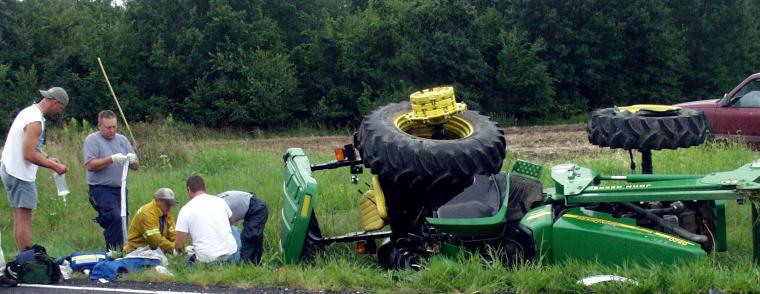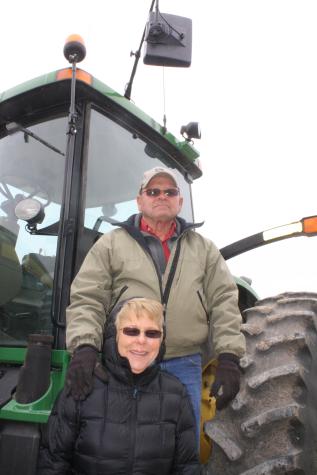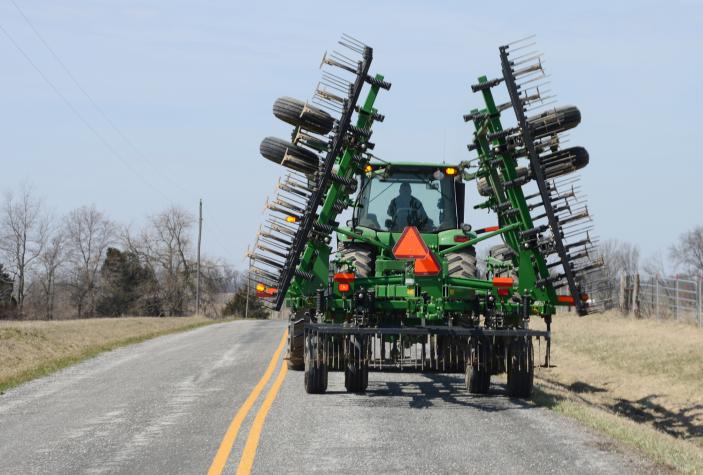SHELBINA, Mo. – It was like any other day in the 40-plus years that Kent Blades had been farming. A lifelong Monroe County farmer, Blades was driving from one part of the farm to another when a semi-truck passed him and struck his John Deere open-station 5520 tractor as he was making a left turn.
Blades counts himself lucky to have survived, though the accident left him with severe brain trauma, multiple broken bones and numerous other injuries.
Every year farmers are killed or injured in similar accidents. According to the Missouri State Highway Patrol, there were 231 accidents in Missouri involving farm vehicles in 2011, killing three drivers and injuring 17 others.
Spring is one of the most dangerous times for driving in rural areas, notes Karen Funkenbusch, a University of Missouri Extension rural safety and health specialist. With 123,039 miles of public roads and almost 108,000 farms, Missouri presents many dangers for motorists in rural communities.
“It’s that time of year when farmers are going to have their equipment on the road moving it from field to field, so we need to slow down, take our time, be patient,” Funkenbusch said.
Blades doesn’t want anyone to go through what he experienced. When he sees a driver following a farm vehicle too closely, or machinery that’s not properly marked, he pulls the driver over and gives sage advice. “Just slow down and pay attention to what people are doing,” he says.
Funkenbusch notes that tractors and combines have top speeds of around 20-24 miles per hour. A car going 55 mph that is 300 feet behind a tractor going 15 mph can close that gap—about the length of a football field—in about five seconds.
“Motorists need to be alert,” she said. “You really don’t have much time when you’re traveling 55 miles per hour.”
For Blades, a few short seconds had long-lasting consequences. During his lengthy recovery at the Rusk Rehabilitation Center in Columbia, he had to resign numerous leadership positions, including chairmanships of the state fair board and his church’s board of trustees. He still farms, but his son-in-law takes care of day-to-day operations.
Ruts still mar the roadside ditch where Blades’ life took a detour six years ago. He and his family cannot pass the accident scene without recalling how a routine farm chore almost turned fatal.
Safety tips
Under Missouri law, farm equipment traveling under 25 miles per hour must display slow-moving vehicle reflector emblems and have proper lighting to increase visibility.
University of Missouri Extension rural safety and health specialist Karen Funkenbusch offers additional recommendations:
- When driving farm machinery on a road or highway, display a red flag measuring 12-14 feet high atop a pole so that the machine can be seen even when hidden by a rise or curve in the roadway.
- When rounding a curve, stay to the right-hand side of the road as much as possible. Avoid soft or steep road shoulders, which may cause the tractor to tip.
- Take extra precautions when driving in the early morning or early evening hours, when visibility is often impaired by sun.
- If traffic lines up behind the farm equipment, pull off or let traffic pass.
- Railroad crossings, especially those without gates, present a special hazard. Never take a safe crossing for granted.
- Use hand signals, electronic signals or both to indicate intentions to turn. Try to avoid wide turns.
- Turn your headlights on, but turn off rear spotlights, which can be mistaken for headlights.
- Avoid being on the road during rush hour, in bad weather and at night.
- Use pilot cars if going a considerable distance, and hang a flag out the window of these vehicles or use a slow-moving vehicle emblem.
For drivers who encounter farm machinery, she offers the following advice:
- Some farm equipment is wider than the road. Don’t assume a farmer can pull over to the shoulder, as it may be steep or soft.
- Pass with caution.
- Do not assume that a farm vehicle that pulls to the right side of the road is going to turn right or is letting you pass. Due to the size of some farm machinery, the farmer must execute wide left-hand turns.
- Do not assume the farmer in front of you knows you are there. Farm equipment is loud.
- Be patient and courteous.
Related MU Extension publications:
To learn about the Missouri AgrAbility Project, a program to help farmers, ranchers, farm workers and farm family members limited by any type of disability or chronic health condition become more successful, visit the Missouri AgrAbility website.


